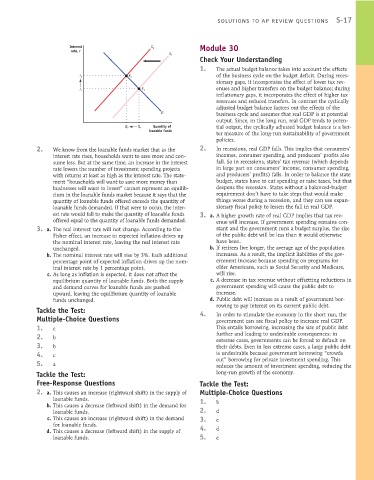Page 863 - Krugmans Economics for AP Text Book_Neat
P. 863
S-17
SOLUTIONS TO AP REVIEW QUESTIONS
Interest S 2 Module 30
rate, r
S 1
Check Your Understanding
1. The actual budget balance takes into account the effects
r 2 E 2 of the business cycle on the budget deficit. During reces-
sionary gaps, it incorporates the effect of lower tax rev-
r 1 E 1 enues and higher transfers on the budget balance; during
inflationary gaps, it incorporates the effect of higher tax
revenues and reduced transfers. In contrast the cyclically
adjusted budget balance factors out the effects of the
D business cycle and assumes that real GDP is at potential
output. Since, in the long run, real GDP tends to poten-
Q 2 Q 1 Quantity of tial output, the cyclically adjusted budget balance is a bet-
loanable funds
ter measure of the long-run sustainability of government
policies.
2. We know from the loanable funds market that as the 2. In recessions, real GDP falls. This implies that consumers’
interest rate rises, households want to save more and con- incomes, consumer spending, and producers’ profits also
sume less. But at the same time, an increase in the interest fall. So in recessions, states’ tax revenue (which depends
rate lowers the number of investment spending projects in large part on consumers’ income, consumer spending,
with returns at least as high as the interest rate. The state- and producers’ profits) falls. In order to balance the state
ment “households will want to save more money than budget, states have to cut spending or raise taxes, but that
businesses will want to invest” cannot represent an equilib- deepens the recession. States without a balanced-budget
rium in the loanable funds market because it says that the requirement don’t have to take steps that would make
quantity of loanable funds offered exceeds the quantity of things worse during a recession, and they can use expan-
loanable funds demanded. If that were to occur, the inter- sionary fiscal policy to lessen the fall in real GDP.
est rate would fall to make the quantity of loanable funds 3. a. A higher growth rate of real GDP implies that tax rev-
offered equal to the quantity of loanable funds demanded. enue will increase. If government spending remains con-
3. a. The real interest rate will not change. According to the stant and the government runs a budget surplus, the size
Fisher effect, an increase in expected inflation drives up of the public debt will be less than it would otherwise
the nominal interest rate, leaving the real interest rate have been.
unchanged. b. If retirees live longer, the average age of the population
b. The nominal interest rate will rise by 3%. Each additional increases. As a result, the implicit liabilities of the gov-
percentage point of expected inflation drives up the nom- ernment increase because spending on programs for
inal interest rate by 1 percentage point. older Americans, such as Social Security and Medicare,
c. As long as inflation is expected, it does not affect the will rise.
equilibrium quantity of loanable funds. Both the supply c. A decrease in tax revenue without offsetting reductions in
and demand curves for loanable funds are pushed government spending will cause the public debt to
upward, leaving the equilibrium quantity of loanable increase.
funds unchanged. d. Public debt will increase as a result of government bor-
rowing to pay interest on its current public debt.
Tackle the Test: 4.
Multiple-Choice Questions In order to stimulate the economy in the short run, the
government can use fiscal policy to increase real GDP.
1. c This entails borrowing, increasing the size of public debt
2. b further and leading to undesirable consequences: in
extreme cases, governments can be forced to default on
3. b their debts. Even in less extreme cases, a large public debt
4. c is undesirable because government borrowing “crowds
5. a out” borrowing for private investment spending. This
reduces the amount of investment spending, reducing the
Tackle the Test: long-run growth of the economy.
Free-Response Questions Tackle the Test:
2. a. This causes an increase (rightward shift) in the supply of Multiple-Choice Questions
loanable funds. 1. b
b. This causes a decrease (leftward shift) in the demand for
loanable funds. 2. d
c. This causes an increase (rightward shift) in the demand 3. c
for loanable funds. 4.
d. This causes a decrease (leftward shift) in the supply of d
loanable funds. 5. e

